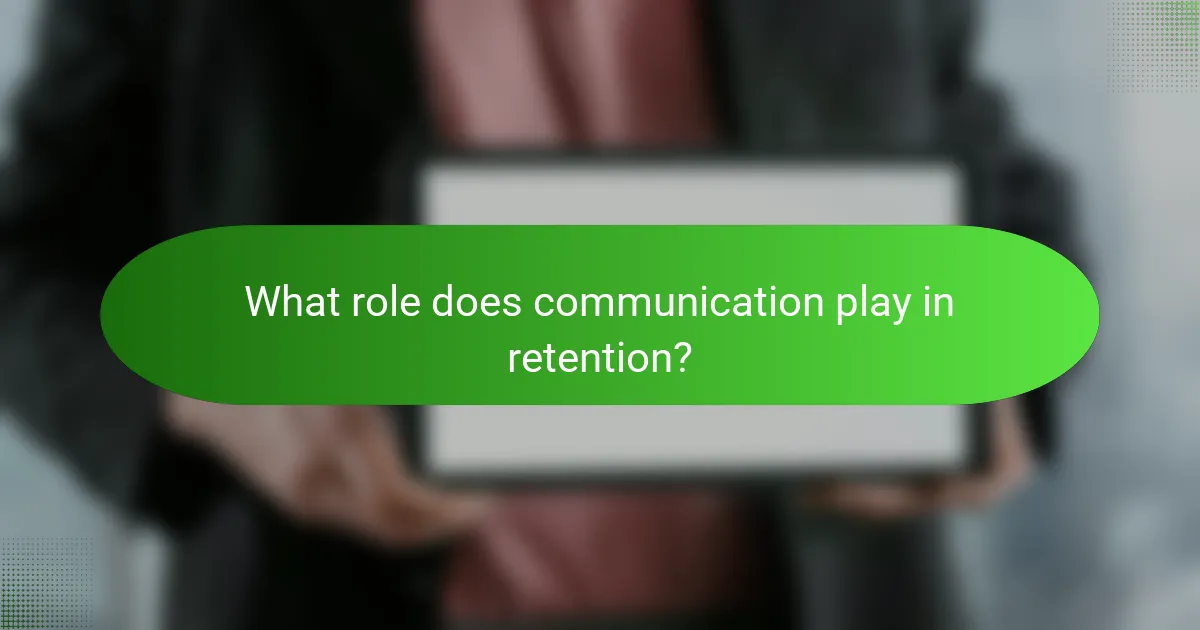During economic downturns, brands face the challenge of maintaining customer loyalty amidst tightening budgets. By implementing targeted retention strategies such as value-driven loyalty programs, exceptional customer service, and personalized promotions, businesses can strengthen their customer relationships. Transparent communication and active social media engagement further enhance brand loyalty, ensuring customers feel valued even in difficult times.

How can brands retain customers during economic downturns?
Brands can retain customers during economic downturns by implementing targeted strategies that enhance customer loyalty and engagement. Focusing on loyalty programs, customer service, personalized promotions, transparent communication, and social media engagement can help brands maintain their customer base even when spending is tight.
Implement loyalty programs
Loyalty programs are effective tools for retaining customers during tough economic times. By offering rewards for repeat purchases, brands can incentivize customers to continue buying, even when they may be cutting back on spending.
Consider tiered rewards systems where customers earn points for every purchase, which can be redeemed for discounts or exclusive products. This approach not only encourages repeat business but also fosters a sense of belonging among customers.
Enhance customer service
Exceptional customer service can significantly impact customer retention, especially during economic downturns. Brands should prioritize quick response times and personalized interactions to make customers feel valued and understood.
Training staff to handle inquiries efficiently and empathetically can lead to higher customer satisfaction. Implementing chatbots for immediate assistance and ensuring easy access to support channels can also enhance the customer experience.
Offer personalized promotions
Personalized promotions can effectively engage customers and encourage loyalty during economic hardships. By analyzing customer data, brands can tailor offers that resonate with individual preferences and purchasing behaviors.
For example, sending targeted discounts based on past purchases or offering exclusive deals to loyal customers can create a sense of appreciation and motivate continued spending. This approach can be more effective than blanket promotions, which may not appeal to all customers.
Communicate transparently
Transparent communication is crucial for maintaining trust during economic downturns. Brands should keep customers informed about any changes in pricing, product availability, or company policies that may affect them.
Regular updates through email newsletters or social media can help customers feel connected and valued. Addressing concerns openly and honestly can prevent misunderstandings and foster loyalty, even in challenging times.
Leverage social media engagement
Social media platforms provide an excellent opportunity for brands to engage with customers and build loyalty. By actively interacting with followers, brands can create a community that encourages ongoing support.
Brands should share valuable content, respond to comments promptly, and run interactive campaigns, such as polls or contests, to keep customers engaged. This not only strengthens relationships but also keeps the brand top-of-mind during economic downturns.

What are effective loyalty programs for economic challenges?
Effective loyalty programs during economic challenges focus on retaining customers through value-driven incentives. These programs should be designed to enhance customer engagement while being cost-effective for the business.
Points-based rewards systems
Points-based rewards systems allow customers to earn points for purchases, which can be redeemed for discounts or free products. This straightforward approach encourages repeat business, as customers feel motivated to accumulate points over time.
To implement a successful points system, consider offering bonus points during promotional periods or for specific high-margin products. A common structure might involve 1 point per dollar spent, with 100 points equating to a $5 discount.
Tiered membership benefits
Tiered membership benefits create a sense of exclusivity and encourage customers to spend more to reach higher tiers. Each tier offers increasing rewards, such as discounts, early access to sales, or exclusive products, which can enhance customer loyalty.
For example, a program might have three tiers: Silver, Gold, and Platinum, where customers unlock better rewards as they spend more. This structure can motivate customers to strive for the next tier, increasing overall sales.
Referral incentives
Referral incentives reward existing customers for bringing in new customers, effectively leveraging word-of-mouth marketing. By offering rewards such as discounts or bonus points for successful referrals, businesses can expand their customer base while retaining current clients.
Consider a program where both the referrer and the new customer receive a discount on their next purchase. This mutual benefit can create a win-win situation, encouraging more referrals and enhancing customer loyalty during tough economic times.

How does customer service impact brand loyalty?
Customer service significantly influences brand loyalty by shaping customer perceptions and experiences. High-quality service fosters trust and satisfaction, encouraging repeat business even during economic downturns.
Quick response times
Quick response times are crucial for maintaining brand loyalty. Customers expect timely answers to their inquiries, ideally within minutes rather than hours. Businesses that prioritize rapid responses can enhance customer satisfaction and reduce frustration.
To improve response times, consider implementing automated systems for common queries or using live chat features. Aim for a response time of under five minutes for live interactions to effectively meet customer expectations.
Empathy in customer interactions
Empathy in customer interactions builds a strong emotional connection between the brand and its customers. When representatives actively listen and acknowledge customer concerns, it fosters a sense of understanding and loyalty. This is especially important during challenging economic times when customers may feel vulnerable.
Train staff to use empathetic language and to personalize interactions. Simple gestures, such as addressing customers by name and expressing genuine concern for their issues, can significantly enhance the customer experience and reinforce brand loyalty.

What role does communication play in retention?
Communication is crucial for brand retention, especially during economic downturns. Clear and consistent messaging helps maintain customer trust and loyalty, ensuring they feel valued and informed about the brand’s status and offerings.
Regular updates on brand status
Providing regular updates about the brand’s status can significantly enhance customer loyalty. This includes sharing information about product availability, changes in service, or any adjustments in pricing strategies. Keeping customers informed fosters a sense of transparency and reliability.
Consider using multiple channels for these updates, such as email newsletters, social media posts, or dedicated sections on your website. This multi-channel approach ensures that customers receive information in their preferred format, increasing engagement.
Feedback solicitation and action
Actively seeking customer feedback is essential for retention. By asking for opinions on products or services, brands show they value customer input, which can strengthen loyalty. Utilize surveys, polls, or direct outreach to gather insights.
However, it’s crucial to not only collect feedback but also act on it. Implementing changes based on customer suggestions demonstrates that their voices matter. For example, if customers express concerns about a product feature, addressing those concerns can lead to improved satisfaction and retention.

How can brands leverage social media for loyalty?
Brands can effectively use social media to enhance customer loyalty by creating engaging content and fostering community connections. These strategies not only keep customers informed but also make them feel valued and part of a larger brand narrative.
Engaging content creation
Creating engaging content is essential for capturing attention and maintaining customer loyalty on social media. Brands should focus on producing high-quality visuals, informative videos, and interactive posts that resonate with their audience’s interests and values. For example, a fashion brand might share styling tips or behind-the-scenes looks at their design process.
Consider using user-generated content to enhance authenticity. Encouraging customers to share their experiences with your products can create a sense of ownership and community. Brands can run contests or campaigns that reward customers for sharing their stories, which can increase engagement and loyalty.
Community building initiatives
Building a community around your brand is crucial for fostering loyalty. Brands can create dedicated groups or forums on social media platforms where customers can connect, share experiences, and provide feedback. This not only strengthens relationships but also allows brands to gather valuable insights directly from their audience.
Additionally, hosting live events or Q&A sessions can further enhance community engagement. These initiatives allow customers to interact with brand representatives and each other, creating a more personal connection. Offering exclusive content or early access to products for community members can also incentivize participation and loyalty.

What are the prerequisites for successful retention strategies?
Successful retention strategies require a deep understanding of customer needs and behaviors, especially during economic downturns. Businesses must prioritize building trust and delivering value to maintain loyalty and engagement.
Understanding customer needs
To effectively retain customers, businesses must first identify and understand their specific needs and preferences. Conducting surveys, analyzing purchase history, and gathering feedback can provide valuable insights. Tailoring offerings to meet these needs can significantly enhance customer satisfaction.
Building trust and credibility
Establishing trust is crucial for retention, particularly in challenging economic times. Brands should consistently deliver on promises, maintain transparency, and communicate openly with customers. Implementing loyalty programs that reward consistent patronage can also foster a sense of reliability and commitment.
Delivering exceptional customer service
Exceptional customer service can differentiate a brand from its competitors and encourage loyalty. Businesses should train staff to handle inquiries and complaints effectively, ensuring quick and satisfactory resolutions. Providing multiple channels for support, such as chat, email, and phone, can enhance accessibility and responsiveness.
Offering personalized experiences
Personalization enhances customer engagement and retention by making customers feel valued. Utilizing data analytics to tailor marketing messages, product recommendations, and promotions can create a more relevant shopping experience. Simple gestures, like personalized emails or birthday discounts, can significantly impact customer loyalty.
Creating a community around the brand
Building a community fosters a sense of belonging among customers, which can enhance loyalty. Brands can create forums, social media groups, or loyalty clubs where customers can interact and share experiences. Engaging with customers through these platforms can strengthen relationships and encourage repeat business.
